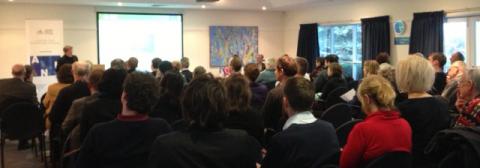You can listen to this Schuman Lecture through the ABC Radio National’s Big Ideas website.
In 2013, the year of Canberra’s Centenary, despite the decision to fashion the Centenary celebrations largely from local and Australian creatives, there’s been ample evidence in the national capital of the continuing links between the cultures of Europe and Australia. This relationship was clear at the time of Canberra’s founding, and by the time Canberra was 50 years old, there were already two Australian arts festivals shaped wholly in Edinburgh’s mould, including the nature of the content, which was mainly European. All of this activity went on in an atmosphere of the widespread invisibility of Aboriginal and Torres Strait Islander cultures which had remained strong for more than 40,000 years. 1963 , year of the 50th anniversary, was also the year of the Yirrkala bark petitions , legal documents created through traditional art , and leading to the referendum which in 1967 gave Aboriginal and Torres Strait Islander people the right to vote.
Many things have changed since then. The gift of Britain to Canberra on the occasion of its 50th birthday was extravagant – the carillon which sits lakeside. 50 years on, the conversation with European Embassies were more about the value of ephemeral gifts, (such as the EU’s support of the Canberra Symphony Orchestra’s concert at Government House) on the mutual understanding that such material extravagance was no longer possible. The celebrations to mark the Centenary of Canberra have had Indigenous culture at their heart, and this year the theatre work Namatjira, part of Big hART’s trilogy of works presented at the Canberra Theatre Centre as part of their residency here, will be seen at Southbank in London to accompany the Royal Academy survey of Australian Landscape, the first for 50 years. In this year too, Gija elder and painter Lena Niyadbi’s Barramundi Scales has been sized up to sit large on the roof of the Musee du Quai Branly in Paris, where all who ascend the Tour Eiffel will gaze down upon it.
In addition, at a time when the mobility of artists is high on the agenda of organizations such as the European Festivals Association, Independent European Theatre Meeting, and A Soul for Europe, there are few impediments to the ease of movement at the highest level. Barrie Kosky is Intendant of Berlin’s Komische Oper , where Benedict Andrews also directs; Simone Young wields her baton in Hamburg; Nicolas Milton ( Artistic Director of the Canberra Symphony Orchestra) is a rising star as conductor throughout Europe, and Jonathan Mills directs his sixth Edinburgh Festival – while four of the seven major arts festivals in Australia have European artistic directors, and all of the major symphony orchestras have European chief conductors.
Both the Edinburgh Festival, and then the European Capital of Culture program, arose from ambitions for a Europe reunited through arts and culture. The festival model was copied in Australia without such ideals, and, in ignorance of ancient practices of art and celebration amongst its Indigenous peoples, as if it were the first of its kind: it took decades to understand that the platforms the festivals created would eventually allow Aboriginal and Torres Strait Islander art to enter those stages, provide a strong profile for their cultures, and begin to develop their own festivals which have proliferated across the country. At the same time, Australians still flock in greatest numbers to exhibitions of European Art (Toulouse Lautrec and Turner in Canberra, Monet in Melbourne), and the output of European theatre and dance still sets the benchmarks for the major festivals.
In her Schumann Lecture, Robyn Archer AO will tease out these themes of connection and contradiction, Australia’s lingering mid-twentieth century dependence on European cultures, the massive changes that have taken place in the last 50 years, and the way these have been reflected during the program for the Centenary of Canberra.
Robyn Archer AO is Creative Director of the Centenary of Canberra, Artistic Director of The Light in Winter (which she created for Federation Square, Melbourne), Deputy Chair of the Australian Council, Chair of the Arts Advisory Board of the Adelaide College of the Arts, and patron and ambassador of many arts organizations including the Institute of Postcolonial Studies and the Arts Law Society. She is also one of only two Australian members of the European House of Culture (the other is Edinburgh-based Jonathan Mills), and a mentor in the European Festivals’ Association’s Atelier, which this year will take place in Beirut. She is a Chevalier de l’ordre des Arts et Des Lettres (France), and an Officer of the Crown (Belgium), both for services to the arts of those countries.
To view the flyer for this event please see: 2013 Schuman Lecture: Culture and Contact: Europe, Australia and the Arts.

Location
Speakers
- Robyn Archer AO - Creative Director, the Centenary of Canberra